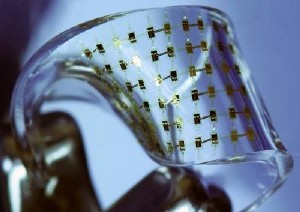Jan 21 2009
Jizhou Song, a professor in the University of Miami College of Engineering and his collaborators Professor John Rogers, at the University of Illinois and Professor Yonggang Huang, at Northwestern University have developed a new design for stretchable electronics that can be wrapped around complex shapes, without a reduction in electronic function.
 This picture shows an optical image of a freely deformed stretchable array of complementary metal-oxide semiconductors inverters. Credit: Professor John A. Rogers and University of Illinois at Urbana-Champaign.
This picture shows an optical image of a freely deformed stretchable array of complementary metal-oxide semiconductors inverters. Credit: Professor John A. Rogers and University of Illinois at Urbana-Champaign.
The new mechanical design strategy is based on semiconductor nanomaterials that can offer high stretchability (e.g., 140%) and large twistability such as corkscrew twists with tight pitch (e.g., 90o in 1cm). Potential uses for the new design include electronic devices for eye cameras, smart surgical gloves, body parts, airplane wings, back planes for liquid crystal displays and biomedical devises.
"Our design is of great interest because the requirements for complex shapes that can function during stretching, compression, bending, twisting and other types of extreme mechanical deformation are impossible to satisfy with conventional technology," said Song.
The secret of the design is in the silicon (Si) islands on which the active devices or circuits are fabricated. The islands form a chemically bonded, pre-strained elastomeric substrate. Releasing the pre-strain causes the metal interconnects of the circuits to buckle and form arc-shaped structures, which accommodate the deformation and make the semiconductor materials much more stretchable, without inducing significant changes in their electrical properties. The design is called noncoplanar mesh design.
The study is featured in the cover of the December issue of the Proceedings of the National Academy of Sciences (PNAS) and was selected for the special section of the journal called "In this issue." The work is titled "Materials and Noncoplanar Mesh Designs for Integrated Circuits with Linear Elastic Responses to Extreme Mechanical Deformations". The study describes a design system that can be stretched or compressed to high levels of strain, in any direction or combination of directions, with electronic properties that are independent of such strain, even in extreme arrangements. These types of systems might enable new applications not possible with current methods.